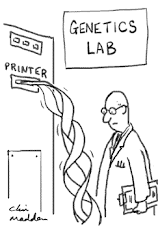
When the term "genetic engineering" is mentioned, what are the first notions that pop up in your mind? For most people, thoughts of fantastical hybrid animals or amalgamations of various connected animal parts appear. For the more imaginative, it may conjure up thoughts of a higher species of super-humans, far superior to our own. In practice, genetically modifying animals is a much more modest technology.
Genetically engineering animals works only because of the fact that all organisms on Earth are made up of the same basic biochemical components. The cells of all organisms on our planet utilize a similar genetic code to delegate specialized tasks, making it possible for scientists to replace or alter these genes to change an organism's appearance, behavior, structure or even their evolutionary process.
The beauty of this technology is that DNA derived from two vastly different organisms may be transferred, giving us some pretty amazing end results. Still, producing these transgenic organisms or GEOs (Genetically engineered organisms) has proved to be much harder than originally believed.
There are two main methods of introducing foreign genetic material into an organism's genome:
Pro-nuclear micro-injection: Usually, genetic modification is carried out by micro-injection.
Using Plasmids:
First,
.svg.png) the desired gene in the nucleus of an organism's cell, containing DNA, is isolated. Second, this desired gene may be placed in a vector, such as a plasmid. The plasmid is the basis of recombinant DNA technology. Plasmids can contain anywhere from 2-250 genes.
the desired gene in the nucleus of an organism's cell, containing DNA, is isolated. Second, this desired gene may be placed in a vector, such as a plasmid. The plasmid is the basis of recombinant DNA technology. Plasmids can contain anywhere from 2-250 genes.A plasmid (or vector when being used to transfer a specific gene) is a tiny, extra-chromosomal DNA molecule, which can be altered by using an enzyme or solution. This creates "sticky", cohesive ends which can fit together with the gene of interest once it, too, has had its shape mutated by the restriction enzyme. A DNA ligase can also be used to strengthen these bonds. After the plasmid is connected with the gene of interest from another organism, it is placed back in the chromosomal DNA host cell. Eventually, the changed plasmid is integrated into the DNA (it creates new connections between the nucleotides: guanine, adenine, cytosine, and thymine in the DNA) and placed within a test subject. Once inside the organism, these cell begins to replicate, spreading the new functionality to all cells in the test subject. The new gene transcribes messenger RNA (ribonucleic acid), which are translated by ribosomes, microscopic organelles within cells, and protein synthesis begins.
 Physical Injection:
Physical Injection:Physical insertion of a desired gene into a fertilized mammalian egg is a much simpler form of genetic engineering. A solution containing a gene of interest is directly injected into a fertilized egg during its early developmental stages using a microscopic syringe. The egg is now placed in a surrogate mother. When offspring are born, they are screened for the desired trait. This gene may or may not be expressed in the offspring. For those who test positive for the gene of interest, further breeding ensues.
Somatic cell nuclear transfer: This process is used extensively in the field of cloning, but somatic cell nuclear transfer can also be used to modify an animal's
 genetic code. The nucleus of an unfertilized egg from a first donor is removed and then replaced with a somatic cell nucleus from another donor. A somatic cell is a body cell (one that is not a sperm or egg cell), containing the genetic material of the organism to be replicated. Next, the egg is cultured in a laboratory. It is at this point that new genetic material may be introduced into the egg by a microscopic pipette. After an electrical shock, the egg begins to duplicate and the embryo is quickly implanted into a surrogate mother. The replicating of strands of DNA now contain the desired gene that was added at the lab. Soon an offspring is born, carrying this new gene.
genetic code. The nucleus of an unfertilized egg from a first donor is removed and then replaced with a somatic cell nucleus from another donor. A somatic cell is a body cell (one that is not a sperm or egg cell), containing the genetic material of the organism to be replicated. Next, the egg is cultured in a laboratory. It is at this point that new genetic material may be introduced into the egg by a microscopic pipette. After an electrical shock, the egg begins to duplicate and the embryo is quickly implanted into a surrogate mother. The replicating of strands of DNA now contain the desired gene that was added at the lab. Soon an offspring is born, carrying this new gene.Here are two videos on this subject:
Gene Splicing
Genetically Modifying Pigs




0 comments:
Post a Comment